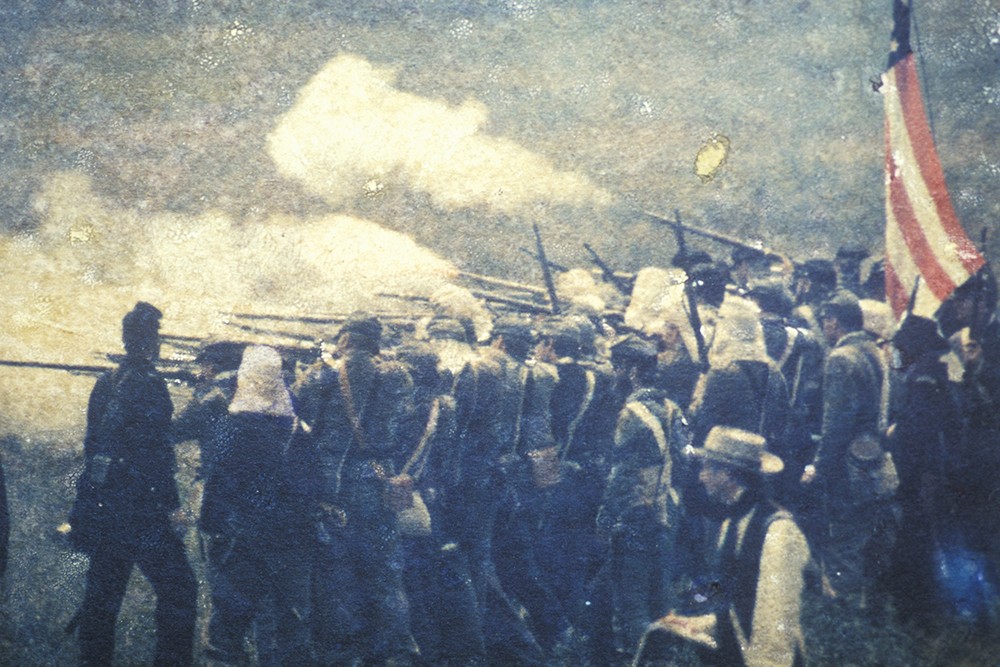
Civil War Reenactment of the Battle at Bull Run
Late summer and fall offer prime seasons to immerse yourself and your family in American Civil War sites and parks while enjoying gorgeous scenery. There are many fun activities, much to see and learn while touring this memorial area set aside to commemorate American history.
The Journey Through Hallowed Ground National Scenic Byway and Hallowed Ground National Memorial Area offer thrilling historical reenactments, fine museums and fascinating displays that present deeply worthwhile explorations for everyone. 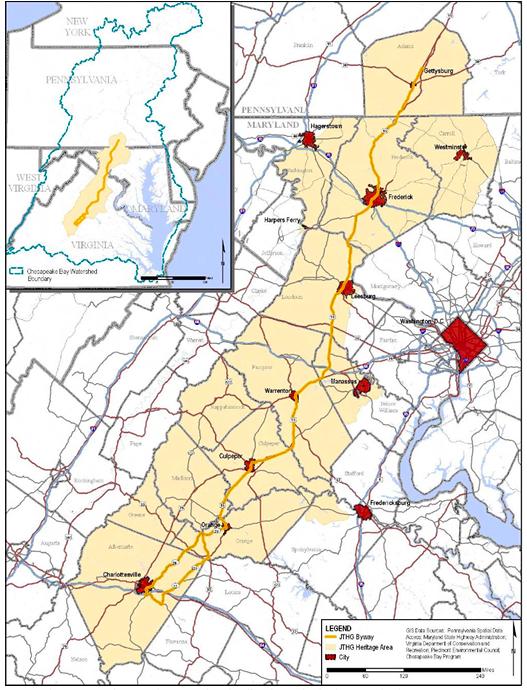
Travelers to Civil War sites enjoy impressive National Parks and Monuments, surrounded by beautiful scenery with bright autumn colors or wildflowers in the spring. Visitors can enjoy the resounding booms of cannon fire, prancing horses and living history demonstrations to see what life was like during those times.
Tour recreated army encampments and enjoy the thrill as splendidly dressed troops reenact the battles. The JTHG Scenic Byway includes 13 National Parks and a listing of 38 historically significant communities and sites within the region .
This centuries-old route traverses the beautiful Shenandoah Valley of Pennsylvania and meanders along the Old Carolina Road from Gettysburg to President Thomas Jefferson’s home at Monticello in Virginia.
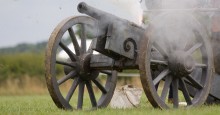
Civil war cannon
Uniquely American Experience
These lands are the scene of many early American experiences: this area sheltered colonial settlers and was the stage of revolutionary American events as well as the Civil War. “Where America Happened” is how the Byway website describes the trip.
Lovely views unfold outside your vehicle as the route winds along rivers, through exciting cities and communities with regional cuisine, breweries, wineries and comfortable accommodations or camping sites.
Roadways and trails through historical scenes and natural parklands give your family opportunities to get out and explore trails and rivers. Explore the JTHG Monuments by biking along canal trails and railway routes, canoeing and kayaking along river waterways, climbing by waterfalls, or swimming expeditions and picnics along canal towpaths.
Or simply take in stimulating exhibits, performances and programs sprinkled throughout your trip.
Pre-trip Planning
Prepare for your battleground tour by visiting nonprofit, travel and park websites listed below. They offer a wide variety of resources and learning guides available for download, and you can plan your road trip around events showcased on these sites. Become acquainted with the destinations through online movies and documentaries about the Civil War.
The Scenic Byway and Memorial Area roams through corners of four states and covers an area 180-mile long and 75-mile wide. It includes parts of US Route 15, US Route 15 Business as well and Virginia Routes 20, 231, 22 and 53. It passes a diverse landscape of farms, orchards and forests as well as historic downtowns, wineries and inns. You also can visit a long list of unique cultural events occurring year round.
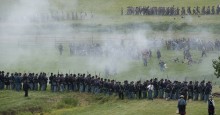
150th anniversary reenactment at Gettysburg
Major points of interest on the Journey Through Hallowed Ground National Scenic Byway are featured on several suggested itineraries to focus your explorations.
Visit HallowedGround.org for selected routes with intriguing titles such as “African-American Heritage”, “A Presidential Journey”, “Orchards & HIghlands Loop”, “Potomac Legacy Group”, “Catoctin Scenic Loop.”
The itinerary takes you through beautiful mountain ranges, lush farmlands, forests and river valleys. Each selection provides complete directions to suggested stops, side trip adventures and are loaded with things to do along your way.
Some have called highways in the Hallowed Ground Scenic Byway district “roads through America’s past”. These road adventures are exciting and engrossing time-travel to discovery for all ages.
Pennsylvania
• Gettysburg National Military Park
Acknowledged by historians as the turning point of the Civil War, Gettysburg marked the end of the Confederate Army’s drive to bring the war deep into the northern states and came after a string of brilliant victories known as “the high water mark of the rebellion.”

Gettysburg at sunrise.
Located at the top of the Shenandoah Valley at the southern border of Pennsylvania, the vast battle was a desperate struggle and could have become another Confederate victory. Discouraged and war-weary citizens on both sides of the conflict were calling for an end to the conflict, which would have dismembered the United States and continued slavery.
The battle’s outcome marked a significant change on both sides. President Abraham Lincoln dedicated the site by declaring, “…The world will little note, nor long remember what we say here, but it can never forget what they did here.”
This National Park website for this battle teems with films, events, reenactments, concerts and living history demonstrations. Educational tours help you understand the battle and take advantage of the experiences at the park.
Make sure to see the visitors center, which features a 360-degree cyclorama oil painting of Pickett’s Charge on view and other interesting exhibits as well as films. Park staff at the Visitors Center provide travelers with routes through the park to match the time you have available for your stay, whether several days or hours.
Highlights of the park include guided battle walks led by historian rangers that provide a thrilling recreation of key moments of the three-day decisive events at the actual locations. Annual Music Muster displays live military band performances and dancing of the era. “Virtual Tours” of specific areas in the park and the film “A New Birth Of Freedom” are available on the NPS website.
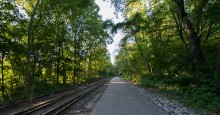
Heritage Rail Trail County Park York Pennsylvania
Take a rIde on the route that carried President Lincoln to Gettysburg on a real steam locomotive! The rail trip follows part of the Northern Central Railroad line through Heritage Rail Trail Park behind the replica steam engine “William Simpson No 17”. In Shrewsbury, PA, take advantage of an Amish farmer’s market to buy Pennsylvania Dutch goodies and crafts.
Maryland
• Antietam National Battlefield
The site is called “the bloodiest day in American History” since both Union and Confederate soldiers were American citizens.
Antietam also is called “a day of hope for freedom” since it was a catalyst for President Lincoln writing the Emancipation Proclamation. Millions of slaves officially were freed after this battle.
Exhibits honor Clara Barton, called “the angel of the battlefield” and founder of The American Red Cross, whose nursing efforts here changed hospitals forever and helped lead to sanitary medical practices.
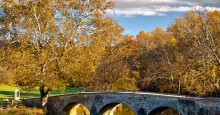
Old stone bridge at Antietam.
• Union Mills Homestead, built in 1797 in Westminster, is where Union Cavalry ran straight into Confederate Cavalry under Maj. Gen. J.E.B. Stuart in the days just before Gettysburg. The well-preserved park features a yearly Encampment reenactment, microbrewery festival, blacksmithing demonstrations and living history exhibits of pioneer life in the 160 years as a working farm.
• National Museum of Civil War Medicine is a great stop in the town of Frederick. The Civil War made huge advances in medical treatment in the field for soldiers.
Technological advances included revolutionizing ambulances, outdoor triage, sanitary practices and the beginnings of anesthetics. Fascinating, beautifully illustrated life-sized exhibits and guided tours tell the stories of patients, caregivers and doctors.
West Virginia
A state created by the Civil War; when Virginia joined the Confederacy and succeeded from the United States, Union sympathizers carved out their own state. Many of the 30 Civil War battle sites in the state are local parks.
• Harpers Ferry National Historical Park
This park is located near the borders of West Virginia, Virginia and Maryland and close to Washington, DC. It preserves the pre-Civil War site where John Brown of Kansas, along with a group of anti-slavery forces attacked the US National Arsenal in a failed effort to arm the slaves and instigate a revolt.
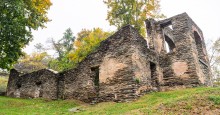
Harper's Ferry Historical National Park.
Many historians consider this event a prophetic precursor of the war that ended slavery in the US. Notably, the battle to retake the arsenal was led by General Robert E. Lee, then the director of the US Army Academy at nearby Annapolis and later head of the Confederate army. At the height of the Civil War in 1862, Confederate General “Stonewall” Jackson again surrounded the town and forced its surrender to the rebels.
The park and town offer many hiking and biking trails and access to rivers. Both Chesapeake Canal Towpath Trail and the Appalachian National Scenic Trail provide portals to lush valleys and steep mountains that beckon visitors to relax in stunning settings.
Virginia
• Fredericksburg & Spotsylvania National Military Park
Four battles in this small area were critical to turn the tide of the war toward Union victory: Chancellorsville, Fredericksburg, The Wilderness and Spotsylvania.
Some 100,000 soldiers were killed or wounded in these intense and costly battles that brought the fighting deep into the heart of the Confederacy. Fredericksburg, a city on the Union Army’s drive to capture the Confederate capital of Richmond, has been called “the most one-sided battle in US history.”
A major victory for the South, some historians refer to this engagement as “the perfect battle” directed by General Robert E. Lee. Pioneering in its breakthroughs in modern medical practices and feats of engineering, such as pre-built sections of pontoon and suspension bridges, are explained. The park has exhibits that fascinate any age.
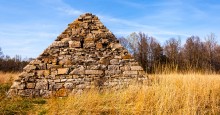
Battlefield pyramid at Fredericksburg
The ferocious battle of Chancellorville, took place inside the city and adjacent forest of The WIlderness. It lasted several days and was called a victory by Lee’s Army of Northern Virginia against the newly appointed commanding general of the Union Army, Ulysses S. Grant.
The battle also was considered a pyrrhic victory – it came at a very high cost to the South in terms of men and dwindling supplies. Although The Wilderness was a horrific but inconclusive battle, General Lee was forced to fall back to Spotsylvania, where General Grant outflanked the rebel forces.
These crucial battles were swiftly followed by the capture of Confederate capital at Richmond and ending of the Civil War.
• Manassas National Battlefield Park
The site of two battles, the First and Second Battle of Bull Run, delivered solid Confederate victories and brought the rebels to the height of their power. It also threatened the nearby US Capitol of Washington, DC.
•Three Presidential homes and plantations are located in this area: Jefferson’s Monticello, Washington’s Mount Vernon and James Monroe’s HIghland. All are fascinating mansions preserved as National Parks.
The sites immerse visitors into the life of their famous owners, their terms as President of the United States, the colonial era’s land-owning class and their enslaved workers. Living history exhibits demonstrate how planters and slaves lived and worked until the end of the Civil War.
Hallowed Ground references
For more details on Journey Through Hallowed Ground Scenic Byway go to HallowedGround.org. It offers a nonprofit website with several itineraries for diverse interests, interactive maps and calendars of events. The map above was created by HallowedGround.org.
The route is grouped under categories including Battle Sites, Historic Towns & Villages, Historical Homes, Historic Sites, Historic Societies, Museums, National & State Parks, Presidential Homes & Sites. The “Things to do” listing at each location featured on the site has “Accommodations”, “Itineraries” and “Wining & Dining” suggestions.
You may also visit the National Park Service for information about Civil War heritage sites. Go to: https://www.nps.gov/places/journey-through-hallowed-ground.htm
Copyright © 2024 by Sensible Driver. All rights reserved.